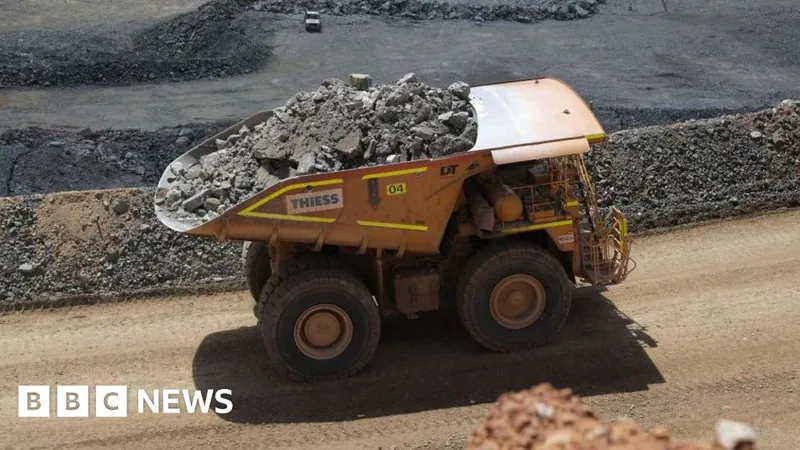
Australia's Lithium Mining Boom Faces Challenges Amid Plummeting Prices
2024-09-26
Author: William
The energy transition is under scrutiny as Australia, the world's leading producer of lithium, confronts a significant downturn in prices for this essential mineral, often referred to as "white gold." Central to rechargeable battery technology, lithium’s affordability has sharply declined by over 75% since June 2023, eliciting concerns across the industry.
This price drop is primarily attributed to a fall in global electric vehicle sales and a burgeoning oversupply of lithium ore. Australia, responsible for 52% of the world's lithium production last year, is feeling the brunt of these market shifts. With vast lithium reserves predominantly located in Western Australia, the nation has positioned itself as a significant player in the global lithium landscape.
As prices plummet, numerous mining operations are forced to shut down or reduce output. For instance, Adelaide-based Core Lithium suspended its operations at the Finniss site, resulting in 150 job losses due to "weak market conditions." Similarly, US multinational Albemarle announced a reduction in production at its Kemerton processing plant, leading to over 300 layoffs. In a more recent move, Arcadium Lithium decided to mothball its Mt Cattlin mine, cited as another casualty of low pricing.
Contrastingly, not every entity is pulling back. Some companies remain optimistic about the long-term prospects of lithium, anticipating a resurgence in demand and prices. Pilbara Minerals plans to ramp up its production by 50% within the next year. Managing Director Dale Henderson remarked on the volatility of lithium prices, asserting a strong belief in the metal's promising future.
Investment firms echo this sentiment. Kingsley Jones, of Jevons Global, highlights that lithium is crucial for the energy transition, particularly for storage batteries powered by renewable sources like solar and wind. However, analysts caution that the oversupply issues might continue to exert pressure on the market until at least 2028.
In light of the fluctuating market, companies like Liontown Resources are forging ahead with their lithium production initiatives. The Kathleen Valley mine, which began operations in July, utilizes solar energy for 60% of its power, showcasing a commitment to sustainability that has garnered commendation, including support from the Australian government's $A230 million investment.
However, the landscape of lithium mining isn't without significant challenges. Lithium extraction in Australia is energy-intensive, requiring approximately three times more energy compared to extraction methods used in Chile and Argentina, where lithium is harvested from brine. This disparity highlights the environmental impact of Australia's hard-rock mining operations, which not only consume more energy but also contribute to higher emissions.
The predominant form of lithium exported by Australia is known as spodumene concentrate, which has also seen a dramatic drop in prices, mirroring the trends seen in refined lithium products. Chinese companies dominate the refining process, converting spodumene into lithium hydroxide and lithium carbonate, where the real profits lie. Currently, the price for a tonne of lithium carbonate is around $10,280, in stark contrast to the $747 fetching for the same amount of spodumene.
In response to the growing need for control over their products, Australian mining firms are increasingly turning towards building their own refining capabilities. This shift could help diminish China's considerable influence, as it currently handles 60% of lithium refining globally.
Despite these ambitions, industry experts warn against the Australian government’s restrictive stance on Chinese investment in this sector, especially given the deteriorating relations since 2020. Critics argue that distancing from the largest consumer is a misstep, with Kingsley Jones advocating for a more inclusive investment strategy.
On the innovation front, Australian researchers are striving to make lithium production more environmentally friendly. Initiatives are underway to develop a new process called “shock quenching,” which promises to avoid the harmful chlorine gas emissions produced by conventional methods. This could pave the way for Australia to become a leader in sustainable lithium production.
As Australia grapples with the dynamics of its lithium sector, companies are also actively exploring battery recycling initiatives. Lithium Australia, for example, is working on extracting lithium and other metals from spent batteries, advocating for a circular economy that minimizes waste and reinforces national capabilities.
As the balance of the lithium market continues to shift, the path ahead remains uncertain. Industry leaders and government officials face the challenge of navigating environmental concerns, global competition, and market volatility while ensuring sustainable practices are at the forefront of Australia’s lithium mining future.









 Brasil (PT)
Brasil (PT)
 Canada (EN)
Canada (EN)
 Chile (ES)
Chile (ES)
 España (ES)
España (ES)
 France (FR)
France (FR)
 Hong Kong (EN)
Hong Kong (EN)
 Italia (IT)
Italia (IT)
 日本 (JA)
日本 (JA)
 Magyarország (HU)
Magyarország (HU)
 Norge (NO)
Norge (NO)
 Polska (PL)
Polska (PL)
 Schweiz (DE)
Schweiz (DE)
 Singapore (EN)
Singapore (EN)
 Sverige (SV)
Sverige (SV)
 Suomi (FI)
Suomi (FI)
 Türkiye (TR)
Türkiye (TR)